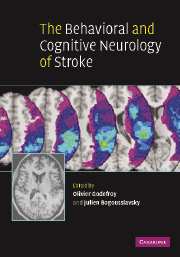Book contents
- Frontmatter
- Contents
- Contributors
- Preface
- 1 Evaluation of cognitive and behavioral disorders in the stroke unit
- Motor and gestural disorders
- Aphasia and arthric disorders
- Hemineglect, Anton–Babinski and right hemisphere syndromes
- Agnosia and Bálint's syndrome
- Executive and memory disorders
- 19 Dysexecutive syndromes
- 20 Disorders of episodic memory
- 21 Working memory dysfunctions in stroke patients
- Behavioral and mood disorders
- Dementia and anatomical left/right syndromes
- Index
- References
19 - Dysexecutive syndromes
Published online by Cambridge University Press: 10 October 2009
- Frontmatter
- Contents
- Contributors
- Preface
- 1 Evaluation of cognitive and behavioral disorders in the stroke unit
- Motor and gestural disorders
- Aphasia and arthric disorders
- Hemineglect, Anton–Babinski and right hemisphere syndromes
- Agnosia and Bálint's syndrome
- Executive and memory disorders
- 19 Dysexecutive syndromes
- 20 Disorders of episodic memory
- 21 Working memory dysfunctions in stroke patients
- Behavioral and mood disorders
- Dementia and anatomical left/right syndromes
- Index
- References
Summary
Introduction
Executive functions and response rapidity are frequently impaired in stroke patients and they represent a core deficit of post-stroke disability. The determinants of these deficits include several factors, the most classical of which is the site of the lesion. “Executive functions and deficits” encompass a large number of processes and impairments, and this terminology has been used with various meanings. Most frequently, executive functions refer to more central functions that control other abilities, and are most detectable in non-routine situations such as novel, conflicting, or complex tasks. The terminology “executive functions” (and dysexecutive syndrome) is now frequently preferred to “frontal functions” (and frontal syndrome) (although perhaps best instantiated in these anatomical areas) because these functions may also be impaired by non-frontal lesions. Disorders commonly considered to be “executive” in origin include a large number of behavioral changes and cognitive deficits. In addition, there is a huge overlap with some attentional processes such as selective, divided, and sustained attention (hence the term “supervisory attentional system”) and these aspects are included in this review. Several reviews have covered this rapidly evolving field (Roberts et al., 1996; Stuss and Alexander 2000; Godefroy, 2003). This review reports recent approaches to the dysexecutive syndrome from a clinical perspective. Several classes of executive disorders have been described and they can be roughly divided into behavioral and cognitive domains (Eslinger and Damasio, 1985; Bechara et al., 1998).
- Type
- Chapter
- Information
- The Behavioral and Cognitive Neurology of Stroke , pp. 369 - 406Publisher: Cambridge University PressPrint publication year: 2007
References
- 16
- Cited by

